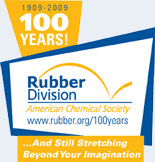![[ Visit ACS Rubber Website ]](images/logo.jpg) |
|
|
Tuesday, April 19, 2011: 9:00 AM
Akron/Summit Ballroom (Akron/Fairlawn Hilton Hotel)
Plasma polymers for reaching reversible metal/elastomer adhesion
Plasma polymers are generally recognized for adhering very well to different types of substrates. The considerable advantage of plasma polymerization is that it is strictly a surface functionalization technique with no effect on the bulk properties of the treated material. By using pulsed, low-pressure RF plasmas and programming the plasma “on/off” time, precise control over the chemistry of the coating can be achieved. Reversible adhesion is of high interest and marketing opportunities for implementing such a technology appear endless. The strategy consists in realizing a Diels-Alder reaction between diene and dienophile groups immobilized respectively on aluminum and EPDM to create strong and reversible interfacial bonds when put in contact. The functionalization of both substrates involves the deposition of a thin maleic anhydride plasma polymer coating followed by a chemical derivatization of the anhydride groups to obtain diene or dienophile groups. The two functionalized substrates are then assembled under slight pressure at 50°C to allow the interfacial Diels-Alder to take place. Peel tests showed that a cohesive fracture was obtained in the EPDM at room temperature which transitioned to an adhesive failure at higher temperature. Surface preparation and analysis will be presented. |
